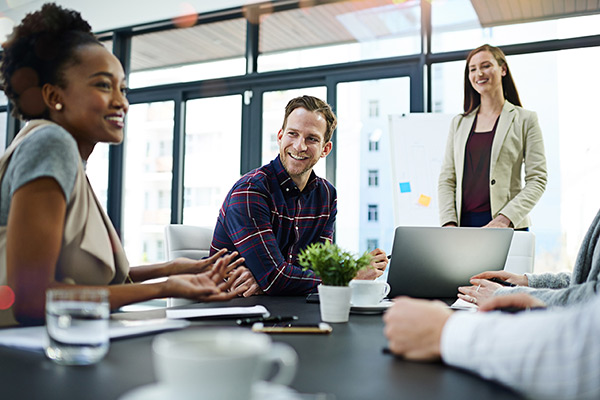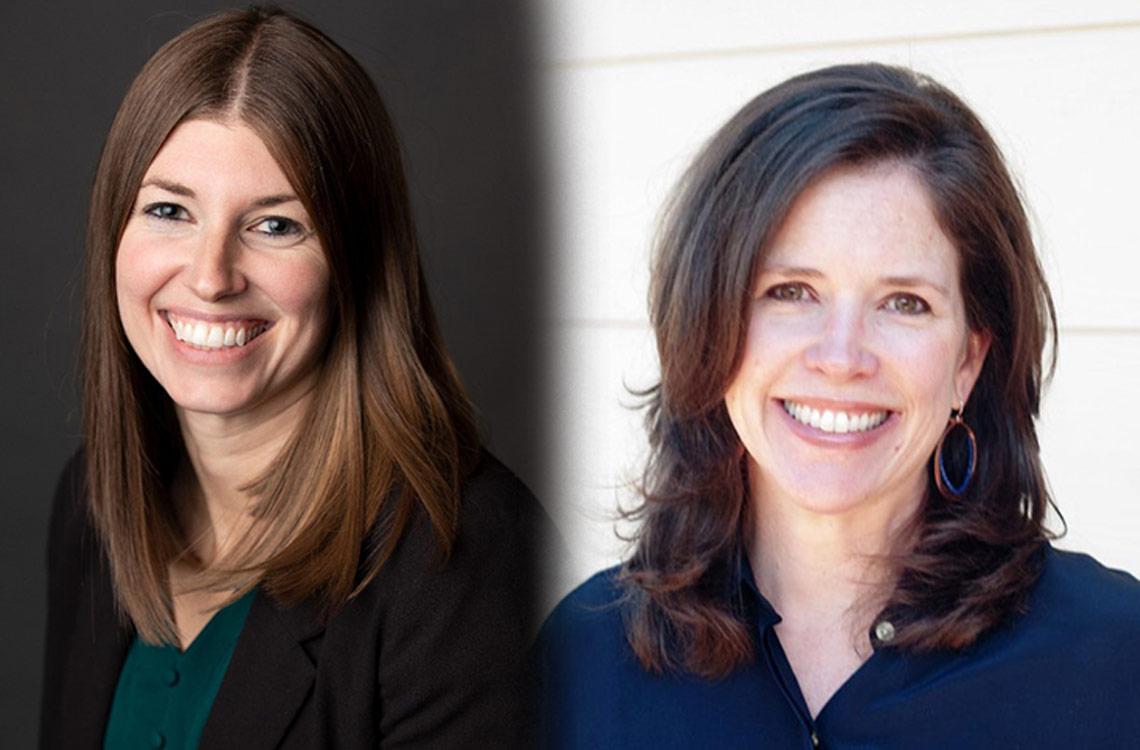The Future Of Employee Listening Strategies With Crystal Robertson And Lee Stroud Of Newmeasures

Employee listening used to be your annual, maybe every other year, satisfaction survey. It was a check-the-box initiative. Are people happy? Do they like their compenben? It was an antiquated process that took a lot of effort and time, and that went mostly unused. But a lot of that is starting to change. In this episode, we are joined by Crystal Robertson and Lee Stroud of Newmeasures, who are knee-deep in developing a new framework for employee listening that may shape the way we do it moving forward. Tune in and get to know what’s in store for employees as employers start to see the benefits of genuine employee listening!
—
The Future Of Employee Listening Strategies With Crystal Robertson And Lee Stroud Of Newmeasures
We are a show that guides leaders on how to elevate the workforce. We believe that people are at the heart of every successful organization. Team members’ well-being, their rewards, and career development are all essential to a happy, healthy, and highly productive workforce. This show discusses the practical and effective leadership strategies for our top executives, senior professionals, and talent managers overall.
I would like to introduce to you some of the hosts that we have on the call. We have Char Miller. She’s a serial entrepreneur. She’s got tons of irons in the fire, a mountain and sea career strategy, and health advocacy. She’s a seasoned Chief HR officer. There is a lot of information you can get from Char. She is known for HR with a heart. We have Howard Nizewitz. He is a seasoned compensation advisor and strategic HR consultant with several years of experience. Howard and I used to work together at Barclays. I’m fortunate to be back with him now. Thank you, Howard, for joining us.
We have Sumit Singla. He is an experienced HR consultant. He is dedicated to helping those small to medium-sized enterprises. He’s known as the culture guy. He has a deep level of expertise from working at companies such as Accenture, Deloitte, Aon, and GE. Sumit brings a wealth of knowledge, and we are fortunate to have him here. Thank you, Sumit. I want to go into our speakers. We have both Lee and Crystal from Newmeasures. I would love to have Lee. You tell us a little bit about your organization, the clients that you help, and a little bit about yourself.
Thank you so much for having us. I’m Lee Stroud. I’m the Owner and President of Newmeasures. We are a boutique firm of industrial-organizational psychologists specializing in designing and implementing employee listening strategies. We focused primarily on small to mid-market organizations. It was an intentional move on our part. We find that we can form solid partnerships with our clients in that space and feel like we are having an impact on all the things that you said. We believe that when employees can thrive, organizations can thrive. We want to continue to help HR teams figure out how to connect those dots.
I have been personally consulting in this space for many years. I’m originally from Alabama. I moved to Colorado for grad school. Once you come to Colorado, it’s a little hard to leave. I have been here ever since. I’m following an organic path in my career. I had an opportunity to take over ownership in Newmeasures. It was not only an opportunity to continue my passion for space but to create a space where we can internally grow amazing leaders, especially female leaders. We are a certified women-owned small business. I’m passionate about growing women leaders on our team. I will let Crystal say hello and introduce herself.
I’m Crystal Robertson. I serve as a Senior Consultant at Newmeasures. My path to employee listening and employee experience space was a little meandering. I have spent most of my career in the healthcare industry, most specifically in healthcare quality. My background is in quality and process improvement.
Change management is a huge piece in the way that the people show up. The change management and improvement process is incredibly important. Anything that we are doing to improve efficiency, effectiveness, and process. Taking the people’s buy-in support and doing it on behalf of the healthcare workers that I worked with was a huge passion of mine.

Employee Listening: Change management is a huge piece in the way that the people show up.
Industrial-organizational psychology is a foundation of a lot of the lenses that we are looking at Newmeasures. That’s my education and training background. I’m fascinated by the study of human behavior at work and am always looking for ways to help support employees, knowing that it supports the organization overall. I’m excited to be here with you.
I love industrial psychology and talking about that. I spent a lot of time in Europe. Several years ago, I used to talk to some of my colleagues here. They would talk a lot about that particular profession. It wasn’t well known in the States as much. Europe got the jump on us there as far as bringing the meat of that content out. I’m glad to hear that it has flourished in the US. That’s deeply needed. When we think about the important part of work, it’s more than getting things done. It’s about how we get it done as humans.
IO psychology is a smaller subfield of psychology. It helps to be able to view the world that way and how we measure the employee experience, everything from what motivates us as individual humans to how we show up for work.
We will certainly mention it in a bit. COVID elevated the human experience at work. It is interestingly related to our topic now. Through our employee listening, we saw an engagement level spike in COVID, which was maybe an unanticipated trend. It’s something that employees are demanding out of their workplace. We are going to talk a lot about how organizations can support that because what people need to thrive is to feel connected to each other as humans and be recognized as individuals.
Let’s dig into that a little bit more. What does employee listening mean in this context?
We will talk a little bit about where it’s been. We will focus a lot on where we are now and a little bit about where we see that going. It has evolved. Employee listening used to be your annual, maybe every other year, satisfaction survey. It was a check-the-box initiative. Are people happy? Do they like their compenben? They never like their compenben. You don’t need to ask the question.
It was an antiquated process. It took a lot of effort and time. Organizations couldn’t do it frequently. Once they got the data, that might even be months after they took the survey. People weren’t sure what to do with it. What we have seen is it’s evolved. A lot is due to the science of industrial-organizational psychology. Satisfaction is fine. What we care about is where the behaviors change. What are those experiences for employees that are going to create that discretionary effort when people are going above and beyond to take care of the organization?
I spent time defining what engagement looks like. How do we impact it? How do we focus on the things that we can control? I will let Crystal speak a little bit more about what we are seeing specifically in engagement. It has evolved. COVID has changed what we know to be some of those key drivers of engagement. Maybe you can speak to that in a little bit of our paper.
When we think about employee satisfaction and measurements in the past, we know that satisfaction doesn’t impact how engaged we are as employees. We can be completely content and satisfied with the work that we are doing. It doesn’t mean that we are necessarily engaged in the work. Satisfaction can impact retention. It will maybe be the impetus for us to continue to stay with the organization that we are working in, but it’s not necessarily going to impact productivity or some of those other outcome metrics that we see.
We know that satisfaction doesn't impact how engaged we are as employees. We can be completely content and satisfied with the work that we're doing. It doesn't mean that we're necessarily engaged in the work. Share on XMoving from employee satisfaction to this idea of employee engagement to start to understand better the employee experience, but not only that. We are interested in what makes people feel motivated and committed to go above and beyond in their work. Why do they get out of bed in the morning to show up at work? We are measuring that discretionary effort from employees.
When we think about what we are learning in terms of the present and what impacts engagement, it’s a lot of different things. You will see a link to our 2023 Newmeasures state of engagement white paper that includes what we have learned, what those key drivers of engagement are, and what matters most to employees.
Creating a sense of community and belonging is a top driver of engagement that we are seeing across our clients. That is different than what we have seen in the past. Several years ago, our clients weren’t even asking survey items about belonging in the workplace. It wasn’t even on an organization’s radar. Now, it’s something that is the top driver of engagement.

Employee Listening: Creating a sense of community and belonging is a top driver of engagement.
Other things that we are seeing that are important to employees are being recognized for the work that they are doing. Focusing on how to grow their career and achieve their career goals is another driver of engagement. Having an organization that’s focused on a clear direction and inspiring vision for the organization is another key driver. Those are the top five drivers we see across our clients.
We are also seeing an emphasis on wellness and well-being. A lot of that was highlighted in COVID. Is it that the employee experience has changed? Is it that we now are recognizing more complex facets of the employee experience? That’s for another conversation, but it does highlight the need that measurement can’t be static. That’s also a trend that we are still trying to get organizations to break free of because we love data, and we want to trend data. We can make predictions. We still need to be able to do that.
Employee listening has to evolve and meet employees where they are now. It also has to tie and align with the organization’s strategy. In the surveys that we designed for our clients, no two are alike because no two organizations have the same strategy, culture, or challenges. We want to make sure it’s rooted in science that we know that we are capturing what the research tells us are the key drivers of engagement, and not be afraid to flex and listen for the things even that we don’t know we need to be listening for.
Employee listening has to evolve and meet employees where they are now. It also has to tie and align with the organization's strategy. Share on XWhen you were talking about the top five things, that resonated with me because Howard and I have been having a ton of discussions in listening to what people and leaders are looking for. Those dominantly came up in every discussion. Recognition was surprisingly moving its way up. There’s a lot of focus on recognition because we are in somewhat of a tough marketplace. The economy is a bit down. Recognition has been found to give a lot of traction in motivating and engaging people when you have a limited budget available to you.
There are a lot of ways that you can go about doing that.
It’s challenging because firms have been tossing around engagement now for years. It’s not a one-size-fits-all. You need to understand the population. It becomes quite complex in terms of how you tailor to meet the needs of the various folks who work for you.
Howard, what we are seeing is where this measurement is going is moving beyond engagement to understanding the broader employee experience. Interestingly, there’s no common definition of what that means or what that looks like. We are going to continue to see that evolve in the next few years. The way that we might start to think about that is by understanding the moments that matter across the employee life cycle.
We are seeing some of that measurement pop up in formal and hopefully informal ways. That’s something else to know. Employee listening doesn’t always mean a survey. We are a survey company, and that’s what we do. We like to promote those informal ways of listening. As you were saying, Sam, about recognition. You don’t need technology or budget to do that and have a meaningful conversation and say thank you in a way that resonates with that person. It’s incorporating informal listening and looking at things like lifecycle surveys.

Employee Listening: Employee listening doesn’t always mean a survey.
What is the onboarding experience? We have data that can tie expectations for career growth in the first 90 days to someone’s likelihood of leaving the organization. We know that that can be a critical moment for people coming into the organization. Return from parental leave. What are those moments or those milestones in an employee’s experience? A change of manager. We want to know and lean into what they are experiencing and understand if there are things that we could be doing differently to support them through that.
Measuring this stuff is hard. It can be difficult to make sure that we are asking the right questions. The workforce experience is something that we have been thinking about deeply for a long time. Sumit, Howard, and I have been writing articles. Sumit and I have put together a book on the topic. I’d love to share it with you. It’s a lot of fun. You mentioned technology. How has technology changed the landscape of how we measure these things effectively and can report them on a more timely basis?
This is this is a hot topic for me. I have a love-hate relationship with technology. Technology can do great things for employee listening. My mantra has always been, “Technology is not going to solve your people’s problems. It’s not the solution. It should support and enable the solution.” People were only listening maybe once a year because it was a paper process. All of that data had to be manually tabulated, entered, and analyzed. The whole process would take months. By the time you are rolling out the results, people forget what they even said on the survey. It created this lag. That had a big impact on why action wasn’t being taken.
Technology has become cost-effective. We have ways to engage with employees where they are in their normal course of work, especially for non-desk workers. That’s been important. We have manufacturing companies. They have been maybe the last ones to jump on board. We know that we can leverage technology to make it easy for their line workers to participate and get their important feedback.
It’s easy to get connected with employees. It’s cost-effective. It can quickly analyze the data so that we are shortening that time on the back end. We have seen people make that be the solution. We are going to do pulse surveys once a quarter. Once a month, we are going to use those little smiley icons to gauge sentiment. They don’t know what problem they are trying to solve. They are capturing data. Data does not necessarily equate to insight.
That’s something that we are passionate about because you have to do this in an intentional way, especially if you have multiple touchpoints that you are assessing across the life cycle. There has to be a common thread from a measurement perspective. We can connect the data in a meaningful way. That’s step one.
Step two is making sure that we are able to visualize that so people can understand how they are connected. Crystal will speak a little bit about the data transparency and data literacy component of that. Before I get there, I will say that the biggest component moving forward that people are most excited about is AI. We have to be careful of the new shiny, bright objects and get distracted because AI is going to solve all of our people’s problems. I do think it’s going to have a big impact. The best way it’s going to do that is by harnessing all of the unstructured data. Open comments, feedback, and organizations want to apply that.
A good example is in exit interviews. We can connect exit interviews with exit surveys. We have quantitative and qualitative data. AI is good at synthesizing all of that information and being able to tell us what people are saying. That’s going to be the best use case for it. As with all of this, if your frontline leaders don’t know what to do with the information, there’s no point. Another real passion of ours is making sure we are equipping frontline leaders to use this data as insight and not initiative. We like to say that the survey data is the how. You have already decided the what. The organization has decided the what people are doing.

Employee Listening: The survey data is the how. You’ve already decided the what.
The data from a survey should inform how you are doing it. Once you have that in your culture and that’s ingrained and embedded, you can use technology to your heart’s desire and survey as frequently as you want to. We are trying to help clients get that fundamental in place before we unleash the technology. Crystal, share some examples with your clients around the data transparency and literacy component.
Some of the tactical applications of AI that we are using before we get there are allowing us to identify comment themes. When we are taking that unstructured and open-ended feedback, we are able to aggregate and summarize it in a meaningful way. Our organizations know what themes are coming up in terms of those open-ended comments and summarizing overall sentiment.
Technology is not necessarily the solution, but it should be aligned with the action-planning approach of the organization. An important point is that depending on what approach the organization has identified in terms of action planning, you can align the technology solution to help support that. Taking action is critically important in this process. Asking for feedback isn’t enough. It’s what we do with the feedback that matters. We can’t ask it. Our employees are looking for us to do something meaningful with it.
Technology is not necessarily the solution, but it should be aligned with the action-planning approach of the organization. Share on XI was in charge of employee engagement for eleven hospitals. I’m the lead consultant for all the other hospitals. I was getting burned out with the employee surveys, even in charge of it, partly because of my frustration as an HR leader that we collect all this data and take all the commentary, which was thousands upon thousands of comments. The executives would say, “We are going to sit and read all these comments.” No, not necessarily.
I watched a lot of executives get defensive about the feedback, almost to the virtual response. I even heard from one of the executives that it made him angry. Sitting around going, “There is an underlying resentment towards this organization and a resentment towards the executive leadership.” When you get brutally honest feedback about the culture and what we can do differently to improve communication, a good leader is not going to get defensive with the feedback and not make people feel fearful of answering honestly on the surveys. Oftentimes, there were negative repercussions for honest feedback to the point where the leaders would be upset with their employees because they gave candid feedback.
I had a CEO. All he cared about was getting 98% participation. I would get in trouble if we couldn’t get 90% participation. It’s more about participation in what the real survey was about and what people were discussing. I have a question for you, Crystal and Lee. How do you help an executive team know what to do with that data? How do you help an executive team not get defensive about the feedback and help make a psychologically safe environment for employees to discuss what they feel about those types of surveys? What are your thoughts on that?
I want to peel back some of it because there’s so much depth to your experience in what you shared. First and foremost, you need employees to feel like they can provide honest feedback. That’s the start. One way that we help support clients do that, and one recommendation I would give is to use a third-party vendor.
Sometimes, in and of itself, having that be separated from the organization helps employees understand that the information that they are providing may be owned by the organization in the aggregate, but the individual-level results can’t be shared with the organization and leadership team. Being able to have a little bit of distance from that.
We apply confidentiality and anonymity thresholds to the data. Small groups of employee data will not be visible. Typically, groups of five or more are required for that threshold to be met to protect data privacy and anonymity. We also recommend that in survey instructions, in a tactical way, we are transparent with employees about what we will do with their comments and open-ended feedback. If it’s going to be shared with a leader, their comments will be visible verbatim.
Sometimes, including that in the instructions of the survey transparently helps employees know that it is okay to share this information, but whatever I’m sharing, I need to make sure that I’m not identifying myself necessarily unless I want to be identified. That’s from the picture from the employee’s perspective.
Employees are also looking at how you communicate about the results once the results are available and how you take action. If this is a punitive process in any way, or leaders feel like you are reviewing the data and it’s based on a scorecard or a report card necessarily, it’s going to create some challenges within your culture where that feedback is not going to be one wanted to be provided. Most importantly, it’s the organization and leadership team taking action on the feedback that they receive in a meaningful way that’s visible to employees.
If action can be taken in a meaningful way, employees will feel like they are seen, their feedback is valued, and they are being heard. They will be more likely to continue to participate. You also mentioned a piece around the frequency and cadence of surveying and creating a sense of survey fatigue. I like to address that piece because I have shifted my mind as a leader in a healthcare organization. As we were taking these surveys, I heard feedback from employees that it felt like survey fatigue and that we were surveying too much, but it was about lack of actioning fatigue.

Employee Listening: If action can be taken in a meaningful way, employees will feel like they’re seen, their feedback is valued, and they’re being heard.
Are we taking action on the feedback? We found that with Newmeasures and working with our clients, our clients and employees within these client organizations are willing to provide their feedback. It’s not seeing anything done with the feedback that provides that hesitation of not wanting to continue to provide it. Why would I want to continue to give my opinion about my work experience when you are not going to do anything with it?
The last piece I’d like to comment on is the vulnerability that it takes for a leader to be able to receive the survey feedback. It is vulnerable to get information and candid feedback from your team. Sometimes, that can feel pointed, direct, and personal. I believe that all of us show up every day and try to do the best job that we possibly can. When we get feedback that might be counter to how we feel like we are showing up as a leader, it can be discouraging.
A couple of things that client organizations do to mitigate that is name the discomfort in getting feedback, recognizing that it’s difficult to hear at times and it can feel personal also, and having the support from your senior leadership team and CEO down to every leadership level to recognize that even negative feedback is an opportunity for learning. How do we reframe it as an opportunity for improvement? Focusing on that continuous improvement is the focal point, not necessarily the score itself.
Char, the elephant here, or the hot potato is who owns the employee experience or engagement. There is a misconception that it’s HR. That’s not true. HR has to facilitate the processes and systems that help support that. A lot of that defensiveness comes in from senior leaders because they feel that they solely own it. We know that there often is such a disconnect between what’s happening at the senior leader level and the frontline level. We know when there’s an absence of information or communication, there can be a lack of trust. That is a common theme that we see.
I’m supposed to be creating this experience, and I don’t know how to do it. That’s the other thing. Leaders don’t know how to fix and do it. They’d rather be defensive and throw their hands in there or not listen. We are going to stop doing surveys. We are in a tough economic period. We are not going to do surveys. What’s the point?
It takes time. I don’t wanna pretend that this is easy. Getting the easy part, figuring out your listening strategy and how you drive change, is an ongoing and difficult process. It requires that everyone owns the employee experience. I have to own my engagement and experience as I have to own that for my team. We have to equip people with how to do that.
The biggest thing is getting the data into the hands of your frontline leaders, which is scary for a lot of organizations. They don’t want to be that transparent. They think they can control the message that it’s not happening. It’s still happening. We have to help leaders understand how to facilitate the right conversations using this data to shape that conversation because that’s how you figure out the what.
I have been having that same conversation with senior leaders for several years. I don’t understand. People don’t get enough communication. I got to do another newsletter, do a town hall, or send out some emails. There are two things that are wrong with that. First of all, you don’t have all the answers. Nobody does. We have to talk to the individuals to understand what they want. I can tell you what they don’t want is more information coming at them. They want to have an opportunity for discussion and dialogue. It feels like they are part of the conversation. There’s that underlying sense of belonging and inclusion. I do think those are some of the conceptual elements that have to be addressed in an organization before we can get to where we need to be.
What do you think, Sumit?
That’s a lot of great stuff to think about, Sam. I was thinking about the use of technology. We run surveys. 60% of people responded to the survey and we got a score of 90% on the survey. Is your actual score 90%? Are the 40% of folks who did not fill out the survey happy they didn’t bother to fill the survey and say, “We don’t want anything to change?” Are they so upset with your organization that there’s no point in filling out the survey and nothing is going to change? Technology or AI will not give us that answer. That’s where the human part of things comes to the four.
The second is when we are lost and looking for a destination, sometimes the best thing to do is to stop, get out of the car, and ask for directions. We don’t do that often enough. We are thinking Google Maps might have got us lost once. It will help us find the way. While looking at the shiny and fancy tools, sometimes forget that the best thing to do is to ask the people, “What do you require? How can I make your life better? What would impact the human experience?”
That’s the second thing that I was thinking of when you said, “It’s tough for leaders to be vulnerable or to embrace change.” One of the suggestions that I give to my clients is that even before you think of a survey or even before you plan for a survey, it’s not that you are completely in the dark about what people are upset about or what they require. Maybe look at some of the low-hanging fruit. We have been hearing some rumbles in the organization about these 1, 2, 3 things. While we are working on the first one, we want to understand more in detail. Here’s a little survey. If you fill up, it will help us in getting your perspective. That drives up the participation rates.
One thing that I would add there is you are saying, Sumit, that leaders know some of the themes. What I have also found is that leaders released this new program they invested a lot of money into. They have been thinking about this for months, but perhaps they didn’t do such a great rollout in communication. What the leader knows is our people should be happy about this. Sometimes, people don’t know this at all. They are wondering. There’s a disconnect in surrounding that communication. Do you often find this, Lee and Crystal, that there is a gap between what leadership perceives and what people feel?
There’s not a magic answer to how you close that gap. I like what you were saying, Sumit. We firmly believe that you have got to find a balance in organization-wide listening, where we are getting quantitative data. We are able to at least trend that data. I hear what you are saying about, is it 90% or not? The important thing is it’s trending in the right direction. With the relative scores, we could debate that, but are we trending on the things that we are putting intentional effort into, as well as bringing in more of that individualized experience and having those conversations and understanding what each person needs individually?
You need to find a balance between organization-wide listening and one-on-one consultations. Share on XI mentioned COVID engagement spiking. It’s because we saw those behaviors happen organically and naturally in organizations. My favorite phrase I heard during that time was, “Same storm, different boats.” We were all experiencing a pandemic, but all in different ways. We all needed different things from our organization to make it okay. Organizations were doing that in unprecedented ways by having those one-on-one conversations.
That is a key step to making sure that we are uncovering where those gaps are. We certainly use quantitative data to identify gaps. We see that all the time. We have got to continue to focus on those one-on-one conversations because that’s where we can dispel knits. That’s where we can challenge the story that we are telling ourselves in our heads. You can’t do that with more top-down communication. It’s natural. People don’t have access to all the information you do as a senior leader. We have got to make sure that we are closing those gaps with those one-on-one conversations.

Employee Listening: People don’t have access to all the information you do as a senior leader. We’ve got to make sure that we’re closing those gaps with those one-on-one conversations.
A couple of tangible examples of what your question, Sam, is about where have we seen that disconnect or gap occur? A couple of things come to mind that I frequently see with client organizations. One is a perception of how well senior leaders believe that they are taking action on feedback in a resonant way with employees, what employees see, and how they perceive that action happening or not. In the action planning phase overall, there are some gaps between how senior leaders feel like they are, they are doing versus how employees perceive that.
Another specific example is around creating an inspiring vision for the future. I’m seeing this a lot with clients now, where executive teams feel like we are communicating our vision all the time in many different forums. Why would we score less favorably than we would expect to see on that particular item?
The conversation that we typically have is about how we cascade information in a meaningful way. At every level of the organization, employees feel like they can connect with the work that they are doing and their job role, specifically their business function and unit, to the goals and strategic plan of the organization. It’s a tangible example, but it isn’t about the senior leader communication of that vision, but it’s also how are we equipping each of our managers, even direct people, leaders at the front lines to that vision and strategy so that they understand how they contribute to that.
That’s an interesting idea that you were talking about earlier of the role of HR and almost as facilitators or custodians of change. It ties in with how it’s not AI resources or AI capital. It’s human capital. The way you report information and the way you influence a leader to take action is completely human-driven. I’m saying 66% of our people are engaged and happy with well-being initiatives, or over one-third of our people are feeling burnt out or unhappy. Will a leader go down two different paths? That’s not something AI can do.
It can provide an overall sentiment. It can’t necessarily be involved in telling the full organizational structure story and the organizational picture.
That leads to a good question I have for you, Howard. I know that you are a huge advocate of systems for efficiency. I’m thinking of some of those dashboards that are important for organizations or managers to see. Where do you think those dashboards stop and we should take more of a human touch?
It’s what we have all been talking about. It’s the context. You are missing that. The dashboards will give you a quick view of whatever it is that you are trying to measure, but it’s not going to give you the full understanding of the story behind those numbers or what’s driving those numbers or tell you what to do with those numbers. It’s a snapshot at a given time.
One of the proponents and pieces that I advocate strongly for Howard is data transparency. You are talking about the dashboard as a tool to share results. What is also incredibly important is getting the results into the hands of the people who can do something with it. The dashboard is one tool and it doesn’t share the story, but making sure that frontline leaders have access to the information about the results is critically important.
I work with a lot of clients who still have some fear about how far to go with data transparency and who need to be involved in seeing results. Until there’s some open discussion about expanding access and permission to be able to view that information, there’s a gap and lack of opportunity to be able to influence and impact real change.
I would love to hear your perspective on the new remote environment. I know that Char and I are often broadcasting from remote locations. I would love to hear your perspective on how we should be thinking about getting good feedback from our remote folks. Is it different than we would and most people who are in the office?
Crystal, I will jump in first and let you speak to some of those specifics that you are seeing. This is important to talk about a broader issue, which is what people need doesn’t vary depending on which country, job you are in, gender you identify with, or remote or in an office. How you deliver on it is where you see those changes and variations.
I have been remote for several years. The only difference is when COVID happened, I had to turn my camera on all the time. I was not happy about having to get dressed every morning. I have always learned how to do that. It is a practice. Our company is, for all intents and purposes, a virtual organization. It takes a different level of intention to craft the culture that we want. As we have been talking about creating that sense of community and belonging, how do you do that in a remote environment?
That’s still a need. It’s still our top driver of engagement. We have to do it a little differently because it’s not going to happen organically in an office. I would say that people are always trying to focus on benchmarks and comparisons. They want to know how things are different. At the end of the day, we are all humans. We all have some of the same basic human needs. How we deliver on it is where it changes. It is up to the organization, their strategy, and locations and how they manage change.
We're all humans. We all have the same basic human needs. How we deliver on it is where it changes. It is up to the organization, their strategy, and locations and how they manage change. Share on XWe have been talking about surveying and listening to our employees. They are willfully giving information back to us. There are a lot of other ways to get information from the workforce. It comes out of the name of surveillance. What’s the common state of this? Is there a good way of doing this without getting feedback directly from employees? We are taking some observations. What are your thoughts on that realm?
It makes me uncomfortable off the bat. We are seeing a lot of that primarily in measuring the customer experience where there’s more surveillance. You don’t have to have that same level of psychological safety. I have yet to see how we can apply that to the employee experience in a way that creates psychological safety and trust.
As Crystal was saying, many of our clients still are fearful about this process. They are convinced that their employees won’t take the survey if it’s authenticated, and we can connect their responses to their personal demographic information. People want to share feedback. If we act out of a place of fear and distrust, we are going to perpetuate that fear and distrust.
If we can break that, act in the way of trust, and show people that we are acting on your data, that we care about you as a person, and we are going to protect your data, we can create more meaningful dialogue and opportunities. We need to create spaces where people can openly communicate and not censor themselves. That’s what would happen if we were using AI or data surveillance tactics, at least as it applies to the employee experience.
You mentioned how you were able to get such high participation rates in some of the surveys you did. Can you shed some light on that? What was your secret sauce?
We use Gallup through a lot of our survey processes. We did everything, the fun celebrations, the chocolate fondue fountains. We used to drive a little miniature car on all the floors of the hospital and give out free food. I did all those activities only with an $8,000 budget for 3,000 employees in one hospital, which is silly. Personally, underneath it all, the nurses working in the middle of the night in the ER who see all these tragedies don’t get appreciated. They are always seeing people push around chocolate and biscuits.
My strategy was to work with the HR business partners to sit down and strategically talk about the prior surveys and build in those touchpoints throughout the year at multiple intervals. Ensuring our leaders, even though they are stuck behind their computers, are constantly replying to a zillion emails to spend more time on the floor and in the work environment and meet employees where they were not sending out a bunch of emails.
I’m from healthcare. It’s not a bunch of emails or newsletters. It’s going out and being with your employees where they are, making sure they have potty breaks and break time to sit with their leaders and have deep conversations like, “What about your refrigerators? What about your water stations?” Stuff that was meaningful. “Why do we not have windows in our laboratory, whereas the big executives have all these fancy windows?” Those underlying things would cause deep resentment.
In short of it, you have to be a change agent. Lee and Crystal are painting that vision of how we are going to create a positive workplace and an environment that appeals not just to the executives but also to the frontline employees and their clients or patients. I put myself in many vulnerable places and got yelled at quite a bit by the employees who were angry, not necessarily at me, but they felt like they weren’t being heard. You have to be strategic. I love what you are saying, Crystal and Lee. I was frustrated with some of our executive teams. I didn’t feel like they were listening. In turn, that helps the employees listen better.
Showing up for your employees in a way that isn’t minimizing the work that they are doing. Sometimes, meeting them where they are. Celebrations, recognition, and food are wonderful, especially in the healthcare space. We love sharing food. In all industries, it’s a way to connect. Are we representing the work and the importance of the value that we are placing and recognizing where employees are coming from?
For example, we throw a pizza party. We are the daytime employees. We put up pizza for them in their work location. If you were a night employee, you had to go down to the cafeteria, walk up to the lady, and say, “I need my free piece of pizza.” Our night employees are like, “We are not being treated equitably like the day. I’m here at 2:00 AM. I have to go to the cafeteria to get my pizza.” The executive would say, “Yeah, we spent $8,000 this year on employee engagement processes, but we are completely missing the point because that was only creating more negativity.” What were you saying, Crystal?
It’s incongruous with what their experience is and meeting all employees in an equitable way. One of the things I’m finding is helpful with our desk list workforce. This includes healthcare, manufacturing, and those others that are on the front lines serving patients, clients, or customers in doing the work. We are making sure that we are providing our support for them to participate in these kinds of activities and making sure that they have formal breaks.
This isn’t something that we are expecting them to do on their off time. This is something that we are making space for. It’s important, and we are going to raise that level of importance by demonstrating to them that they can do that while they are at work and making it easy for them to access the process and be involved.
I love your term change agent. That’s fundamentally why employee listening and engagement stays as an initiative. Senior leaders don’t understand what we are trying to do with this. They don’t understand that this needs to be embedded in your culture and organization. We are trying to drive organizational performance through a compelling and differentiating employee experience.
How do we do that? We have to know what the experience is. To your point, we have to know the whole experience. “Why aren’t there windows in the lab? Why are you making me go down to the cafeteria at 2:00 AM?” It’s the entire experience. It’s not a point in time. What is my engagement with my role? It is understanding the whole employee experience so that individuals and organizations will thrive. If we can continue to bring HR leaders along to understand the strategic component of this, this is not a service offering. This isn’t a standalone solution or initiative. This is a strategic process and way of thinking that we have to ingrain throughout the entire organization.
I agree with you, too. This is awesome. Thank you.
Thank you, Lee and Crystal. It’s been a great conversation. We are coming toward the top of the hour. I want to point out our next speaker to our readers. We are going to be hearing Andreea Pap talk about wellness programs to create a well-being culture. We are going to talk about that journey in the next episode. One thing I want to cover before we let Lee and Crystal go for the week, and it’s been such great information. Thank you so much. What do we want our readers to take away from this conversation? What are the key points that we want them to think about?
If I would summarize some of the key takeaways from my perspective, it’s highlighting the human experience, as you have heard us say, which sounds funny coming from a measurement perspective. Measurement is important. We have to have the measurement. We can’t do it to the detriment of the individual and human experience.
We have to ingrain this in how we approach life and our jobs. This can’t be a standalone initiative. The more we can equip our leaders to think that way, to use this data as insight and not as creating more to do, that’s where we will continue to see real traction to lay out that strategy for the organization. To be comfortable taking a step back, even if that means pushing pause on listening to say, “What are we trying to solve for and what’s the best way to solve it?” We move forward with the intention to build it and bring the technology along to support that. Those would be some of my key takeaways.
Don’t let fear hold you back. Don’t be afraid to ask for feedback, especially during times of tremendous change within the organization. Don’t be afraid to share results. Don’t be afraid to include frontline leaders and managers who can help support and take responsibility for improving the work experience.
For our readers who want to learn more and see what Newmeasures have to offer or talk a little bit more to Lee or Crystal, how can they get ahold of you?
We would love for anyone to reach out. We do have our engagement trends paper that you can download. We will also include my email address. I would love for anyone to reach out. We are offering a free 30-minute listening strategy session. If you are feeling stuck in your current listening strategy or don’t know where to begin, we’d love to talk through that with you and what that could look like. Feel free to ping me. We would love to connect.
Thank you so much for joining us and sharing your wisdom on this topic. It’s been great. Thank you so much.
Thank you.
Thank you so much.
Take care, and we will see everybody on the next episode. Bye, everyone.
Important Link
About Crystal Robertson
 Crystal Robertson, Senior Consultant, has experience supporting organizations in quality and process improvement, change management, and leadership coaching. Crystal has more than 15 years of experience leading individuals and teams in the healthcare industry. She combines science and practice to help leaders build effective and high-performing organizations by aligning strategy to business outcomes and creating work environments where employees can thrive.
Crystal Robertson, Senior Consultant, has experience supporting organizations in quality and process improvement, change management, and leadership coaching. Crystal has more than 15 years of experience leading individuals and teams in the healthcare industry. She combines science and practice to help leaders build effective and high-performing organizations by aligning strategy to business outcomes and creating work environments where employees can thrive.
About Lee Stroud
 Lee Stroud, M.A. is Newmeasures’ Principal and President. Lee has been helping leaders leverage employee surveys and talent assessment data to guide critical business decisions for more than 20 years. Lee’s extensive experience and her degree in I/O Psychology give her the skills to effectively balance science and practical application when helping clients create a listening culture. Lee is particularly passionate about demonstrating the bottom-line impact of the employee experience. Her belief that listening programs should be aligned with each organization’s strategy is foundational to the Newmeasures approach.
Lee Stroud, M.A. is Newmeasures’ Principal and President. Lee has been helping leaders leverage employee surveys and talent assessment data to guide critical business decisions for more than 20 years. Lee’s extensive experience and her degree in I/O Psychology give her the skills to effectively balance science and practical application when helping clients create a listening culture. Lee is particularly passionate about demonstrating the bottom-line impact of the employee experience. Her belief that listening programs should be aligned with each organization’s strategy is foundational to the Newmeasures approach.




